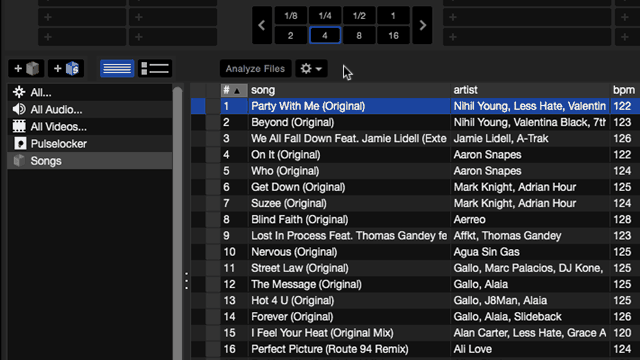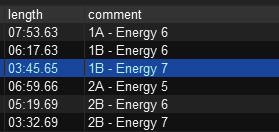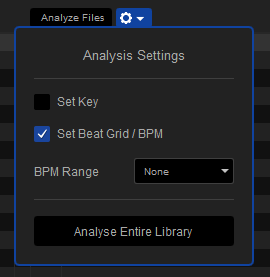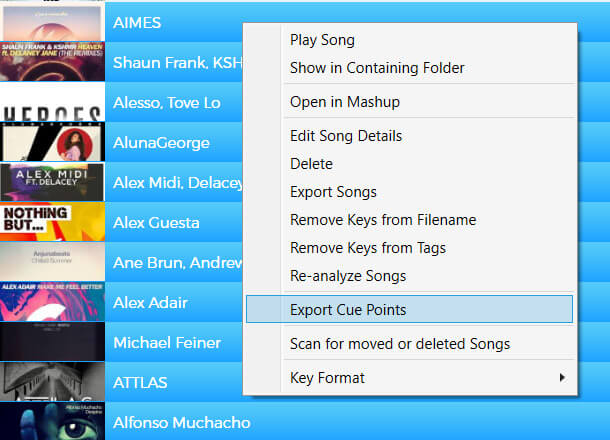Integration
Serato
It’s important to make sure that your Mixed In Key results show up in Serato correctly. It’s not always obvious if you’re seeing Serato’s built-in results, or the premium Mixed In Key results. This tutorial will make sure that you get the right results.
How are the results different? We have our own, patented algorithm. We’ve been in business for 19 years and have always innovated and improved our algorithms. According to indepedent studies, our algorithms are significantly more accurate for your DJ mixing. When you use the results from Mixed In Key, you will have total confidence that your DJ mixing will sound perfect in front of your audiences and the promoters who book you to play.
How to save your Mixed In Key results into Serato

- Add your files to Mixed In Key, and analyze them
- Please disconnect your DJ hardware, as this is required for Serato analysis
- Open your Serato, click on the Analysis Settings icon. Enable “Set Beat Grid / BPM” only. “Set Key” should be turned OFF
- Select the files in your Serato playlist and drag them onto the Analyze button inside Serato
- Serato will load the results from Mixed In Key. You will see the Key and Energy shown in Serato’s Comments column, like this: “2A – Energy 7”. Your Mixed In Key results (KEY, ENERGY and CUE POINTS) are now available to use inside Serato:

Recap: if you see results like “1B – Energy 7” in Serato’s Comments column, that means you’re all set. Your results came from Mixed In Key. If you don’t see that after dragging files onto the Analyze button, let’s troubleshoot at the bottom of this tutorial.
How to snap Mixed In Key’s cue points to the Serato beatgrid
Mixed In Key can automatically set up to 8 cue points for each track in your Serato library. Here’s the special trick to guarantee that your Serato cue points sound good:
- Enable “Set Beat Grid / BPM” in your Serato Analysis settings:

- Select your files inside Serato, and drag them onto the Analyze button to analyze the beatgrid. You’ll know when this is finished because your Serato library will show the “Length” of each track:

- Now open your Mixed In Key and analyze your files if you haven’t already
- Select all your tracks inside Mixed In Key, right-click to bring up this menu:

- Click on the “Export Cue Points” command
- Your cue points will now show up in Serato, perfectly snapped to the Serato beatgrid.
- It’s important to know: the cue points snapped to the grid because you analyzed the beatgrid in Serato first, then re-exported the cue points from Mixed In Key afterwards.
- Play around in Serato and enjoy!
If you need help, email us!
We’re DJs too, and we’re happy to help you. You can always email us directly: [email protected]. Here are some common tutorials that might be helpful to solve any problems quickly:
1. Problem solving: Key and Energy are not showing up in Serato
#1 reason is that Serato is showing old key results from another key detection. To solve this problem, check the following:
- Go into Mixed In Key’s “Settings”, click on the “Update Tags”
- Make sure that “Key + Energy” is enabled. Make sure that it’s saved “Before Comments”
- Make sure that Initial Key checkbox is enabled
- Click on the “Retag existing files” button to write ID3 tags again
- Open your Serato, select the files you want to re-analyze, and drop them onto the “Analyze” button
- If you see the Key and Energy results show up in your Comments column, the problem has been solved:

- You’re ready to play! The same key result should be visible in your Comments column and the Key column in Serato. Those results came from Mixed In Key.
- If you need more help, email us at [email protected]
2. Problem solving: Cue Points not showing up
- Go into Mixed In Key’s “Settings” and look for the “Export Cue Points” settings.
- Make sure that “Serato” is checked and “Yes, Mixed In Key should overwrite Cue Points” is checked
- Click the button for “Export Cue Points for Existing Files”
- Open your Serato, load a track into a Serato deck, and your cue points should show up:

- If you need more help, email us at [email protected]
That’s it for now. Do you have ideas on what else we should explain? Please email us and we’ll respond to you and update this tutorial.
-Yakov and the Mixed In Key team